
The pulse width type parameter allows you to apply patterns to the pulse width when the pulse type is trapezoidal or raised cosine. These patterns include: Linear Ramp, Staggered, and Stepped. A unique pulse width pattern can be applied to each pulse in the Pulse Building application.
The pulse width pattern is generated during a download. The pattern generator will clip values that are out of range. A common example of this is when the pulse width pattern generator calculates a value that is greater than the current PRI. The pattern generator will return the smaller of the value calculated or the current PRI. The signal will be generated unless the target hardware does not have the required capabilities.
The current Pulse Builder Pattern property “Repeats” is used to specify the number of times to repeat the pulse on each line. For example, a Stepped width pattern can be selected, but if the number of Repeats is set to one (1), no pattern is generated. The exception to this is when the given pulse is use on multiple lines within a pattern. See the following example.
A given pulse may be used several times within a pulse pattern. When a given pulse is used throughout the pulse list, its pulse width pattern continues sequentially without reset. In this example two pulses are used in the pattern. New Pulse 1 has a “Stepped” pulse width pattern that increases from 10 us to 20 us using 11 steps of 1 us each. New Pulse 2 has a constant pulse width of 5 us. The following figure shows where New Pulse 1 and New Pulse 2 are used in New Pattern 1.
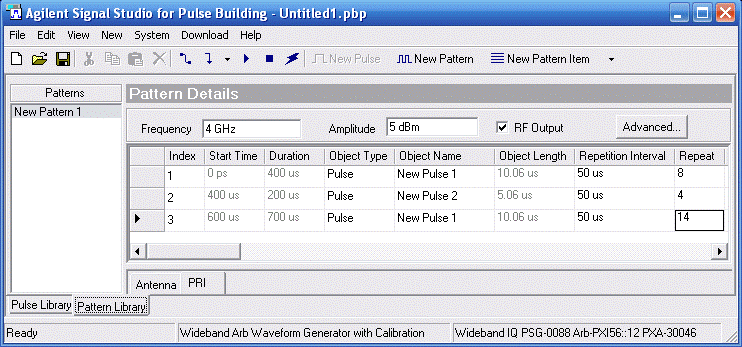
New Pulse 1 is repeated 8 times, New Pulse 2 is repeated 4 times and finally New Pulse 1 is repeated an additional 14 times. The following figure shows the measured pulse widths generated by New Pattern 1 where the stepped pulse width pattern continues and repeats after the fixed pulse width. Notice how the pulse width pattern for New Pulse 1 continues without reset after New Pulse 2.
When nesting patterns, the pulse width pattern continues when the pattern object is used on multiple lines within the new pattern. The pulse width pattern does not continue when the pattern object is used only once and the Repeat property is greater than one. In this case the pulse width pattern created by the pattern object is repeated only the specified number of times.
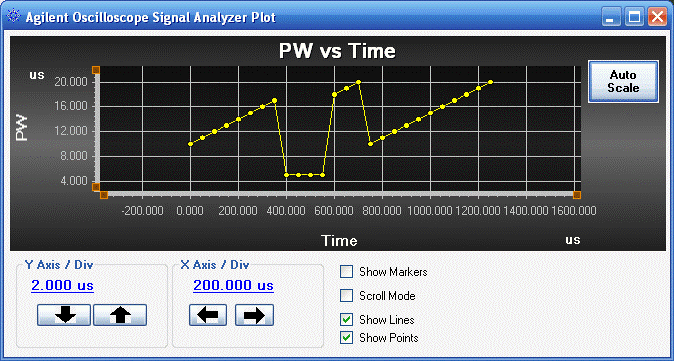
Changing the Pulse Width Type resets some of the pulse width pattern properties. The actual width can be modified by the pulse width jitter value. Pulse width jitter is an impairment that can be used in addition to the pulse width pattern.
- the pulse width is constant for all pulses generated.
- creates a linearly increasing or decreasing pulse width pattern. You can set the Pulse Width Start, Pulse Width Stop, and enter the Number of Pulses in the pattern. The number of repetitions specifies the total number of pulses generated allowing partial and multiple repetitions of the pattern to be generated. Pulse Width Start is coupled to the 100%-100% pulse width property. Changing one will change the other.
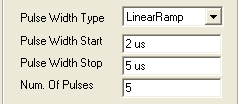
- creates a user-defined pulse width pattern by entering 1 to n staggered pulse width values.
The pulse width values can be added using the Edit menu. The number of repetitions specifies the total number of pulses generated allowing partial and multiple repetitions of the pattern to be generated. The stagger pulse widths are maintained in a variable length double array. The number of pulses is equal to the length of the array.
You can also import a previously saved file containing the pulse width data. The file format is ASCII and the data is assumed to be in seconds. The number of pulses in the staggered pattern is determined by the number values imported. When importing new values, existing pulse width data is deleted first. Changing the Pulse Width Type deletes the imported pulse width data. The first pulse width in the list is coupled to the 100%-100% pulse width property. Changing one will change the other.
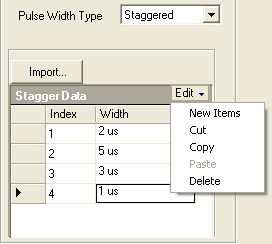
- creates a user-defined stepped pulse width pattern where you can specify the Pulse Width Start, Pulse Width Step size, Number of Steps, and the Pulses per Step in the patten. The total number of pulses in the pattern is calculated by multiplying the number of steps times the pulses per step. The number of repetitions specifies the total number of pulses generated allowing partial and multiple repetitions of the pattern to be generated. Pulse Width Start is coupled to the 100%-100% pulse width property. Changing one will change the other.
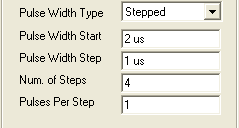
This property is used by the Linear Ramp and Stepped pulse width patterns. Pulse Width Start also maps to the Width (100% - 100%) property.
|
Default |
Min |
Max |
|---|---|---|
|
1 us/2 us1 |
0 |
1 s |
This property is used by the LinearRamp pulse width pattern. Changing the Pulse Width Pattern Type resets this property.
|
Default |
Min |
Max |
|---|---|---|
|
5 us |
0 |
1 s |
This property is used by the LinearRamp pulse width pattern. Changing the Pulse Width Pattern Type resets this property.
|
Default |
Min |
Max |
|---|---|---|
|
5 |
1 |
10000 |
This property is used only by the Stepped pulse width pattern. Changing the Pulse Width Pattern Type resets this property.
|
Default |
Min |
Max |
|---|---|---|
|
1 us |
–1 s |
1 s |
This property is used by the Stepped pulse width pattern. The total pulses in the pattern equals Pulses Per Step x Number of Steps. Maximum pulse limit is hardware dependent. Changing the Pulse Width Pattern Type resets this property.
|
Default |
Min |
Max |
|---|---|---|
|
4 |
1 |
10000 |
This property is used by the Stepped pulse width pattern. The total pulses in the pattern equals Pulses Per Step x Number of Steps. The maximum pulse limit is hardware dependent. Changing the Pulse Width Pattern Type resets this property.
|
Default |
Min |
Max |
|---|---|---|
|
1 |
1 |
10000 |
The first width item in the list is mapped to the Width (100% - 100%) property such that changing the value of one property will change the value of the other. Changing the Pulse Width Pattern Type resets this property.
|
Default |
Min |
Max |
|---|---|---|
|
1 array element |
0 |
1 s |